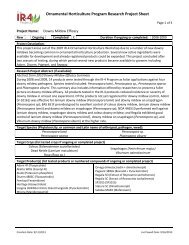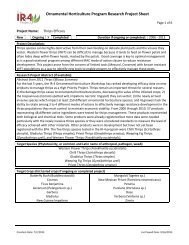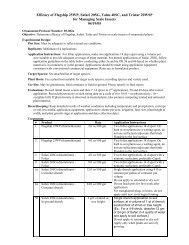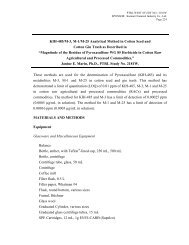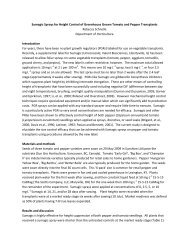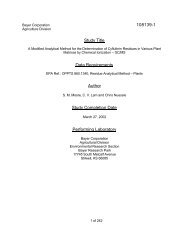Bayer CropScience AG Page 1 of 82 BCS-RD-D ... - IR-4 Project
Bayer CropScience AG Page 1 of 82 BCS-RD-D ... - IR-4 Project
Bayer CropScience AG Page 1 of 82 BCS-RD-D ... - IR-4 Project
Create successful ePaper yourself
Turn your PDF publications into a flip-book with our unique Google optimized e-Paper software.
<strong>Bayer</strong> <strong>CropScience</strong> <strong>AG</strong> <strong>Page</strong> 27 <strong>of</strong> <strong>82</strong><br />
<strong>BCS</strong>-<strong>RD</strong>-D-ROCS Method-No. 00857<br />
D-40789 Monheim Report No. MR-099/04<br />
4.3.6 MS/MS Conditions<br />
The detection by MS/MS was performed on a triple-quadrupole tandem mass<br />
spectrometer, equipped with a Turbo IonSpray (ESI) interface operated in positive ion<br />
mode and multiple reaction monitoring (MRM). Unit mass resolution was established<br />
and maintained in the mass resolving quadrupoles by maintaining a full width at halfmaximum<br />
(FWHM) <strong>of</strong> between 0.7 and 1.0 amu. Optimal collisionally-activated<br />
dissociation (CAD) conditions for fragmentation <strong>of</strong> the analytes and the corresponding<br />
13<br />
C3-labelled internal standards were determined with nitrogen as collision gas. The<br />
conditions are described in detail in Appendix 5 to Appendix 8.<br />
Detector: Triple Quadrupole Tandem Mass Spectrometer, e.g. Applied Biosystems MDS<br />
Sciex API 4000, Windows 2000, Analyst 1.4 or higher s<strong>of</strong>tware versions<br />
Interface: Turbo IonSpray (ESI)<br />
Gas Temperature: e.g. 650°C<br />
Scan Type: MRM (Multiple Reaction Monitoring)<br />
Polarity: Positive<br />
Table 6: MS/MS Parameters for the Determination <strong>of</strong> BYI08330 and BYI08330-enol.<br />
Precursor Ion<br />
Q1 Mass (amu)<br />
Product Ion<br />
Q3 Mass (amu)<br />
Dwell Time<br />
(msec)<br />
Collision<br />
Energy (eV)<br />
BYI08330 1 st MRM 374 216 250 47<br />
BYI08330 2 nd MRM* 374 302 50 23<br />
BYI08330 13 C3 377 219 200 47<br />
BYI08330-enol 1 st MRM 302 216 250 39<br />
BYI08330-enol 2 nd MRM* 302 270 50 29<br />
BYI08330-enol 13 C3 305 219 200 39<br />
Note: Different MS/MS-instruments may result in different MRM transitions.<br />
*: These transitions were used for confirmation.<br />
Table 7: MS/MS Parameters for the Determination <strong>of</strong> BYI08330-ketohydroxy, BYI08330-monohydroxy<br />
and BYI08330-enol-Glc .<br />
Precursor Ion<br />
Q1 Mass (amu)<br />
Product Ion<br />
Q3 Mass (amu)<br />
Dwell Time<br />
(msec)<br />
Collision<br />
Energy (eV)<br />
BYI08330-ketohydroxy 1 st MRM 318 268 150 29<br />
BYI08330-ketohydroxy 2 nd MRM* 318 214 50 39<br />
BYI08330-ketohydroxy 13 C3 321 271 100 29<br />
BYI08330-mono-hydroxy 1 st MRM 304 254 150 27<br />
BYI08330-mono-hydroxy 2 nd MRM* 304 119 50 47<br />
BYI08330-mono-hydroxy 13 C3 307 257 100 27<br />
BYI08330-enol-Glc 1 st MRM 464 270 150 45<br />
BYI08330-enol-Glc 2 nd MRM* 464 216 50 53<br />
BYI08330-enol-Glc 13 C3 467 273 100 45<br />
Note: Different MS/MS-instruments may result in different MRM transitions.<br />
*: These transitions were used for confirmation.



